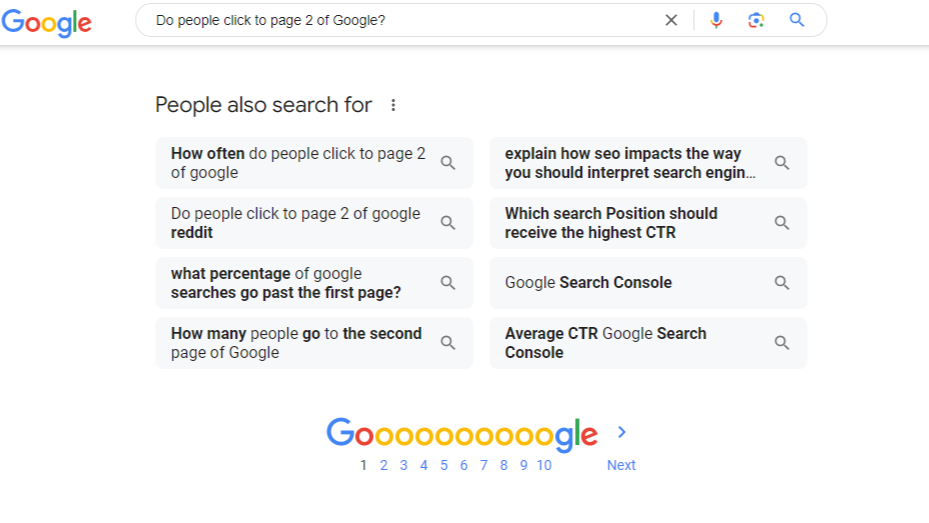
ICYMI: Google Discontinues Continuous Scroll - What it means for SEO
In what seems like a small but potentially impactful change for SEO, Google has decided to discontinue its continuous scroll feature (also known as "infinite scroll").
Initially introduced in October 2021 for mobile users and later for desktops in December 2022, continuous scroll allowed you to view multiple search results pages without clicking “Next.” Instead of seeing the traditional “Gooooooooooogle” bar at the bottom of the page, you could simply keep scrolling.
However, as of June 25, 2024, Google has reverted back to the traditional pagination method on desktop, with plans to make the same change for mobile users soon.
What Was Continuous Scroll?
To improve user experience and make searching easier, search results would automatically load once a user reached the bottom of the results page. This was similar to the experience on social media, where content keeps loading as you scroll down. This feature first appeared on mobile devices in 2021 and was later rolled out for desktop searches in 2022.
In addition to improving the user experience, Google's implementation of continuous scroll might have had revenue-related motivations, particularly related to ad impressions. Without the barrier of clicking "next" to page 2, users would would scroll lower in the search results and, thus, encounter more sponsored links, potentially leading to more clicks (and higher ad revenue).
Reasons for Removal
After continuous scroll was introduced, the results were fairly mixed, especially for desktop users. Websites ranked 15th-20th saw an increase in impressions from 20% pre-continuous scroll to 25% post-continuous scroll. But after that, there was no real noticeable impact.
Regarding clicks, the study found that click-through rates (CTRs) for positions beyond the 6th position increased from 2% to 4% after the introduction of the continuous scroll. Essentially, even with the removal of "page 2," people remained mostly focused on the top 3 search results.
On mobile, the scrolling experience feels more natural, akin to social media. So, it makes sense that impressions were spread out across search results, with 40% of impressions going to the top 3 results and 35% going to the top 7-10.
Unfortunately, this didn't translate to clicks. 91% of mobile clicks on the search results went to the top 3 results with continuous scroll.
The decision to revert back to “pagination” could also be attributed to efficiency. Continuous scrolling made searches slower because it required loading multiple pages at once, which costs more to maintain.
Despite its potential, continuous scroll didn’t quite meet Google’s expectations. Users weren’t necessarily finding it more helpful, and it required more resources to keep loading those extra results continuously.
领英推荐
What This Means for SEO
As Google transitions back to pagination from continuous scrolling, the implications for SEO are twofold. Initially, it might seem like a minor change since the core objective of SEO—to secure the highest possible ranking—remains unchanged. However, this shift could significantly influence user behavior, the importance of ranking higher, and ad spending strategies.
Change in User Behavior
Users who became accustomed to continuous scrolling may have been more inclined to explore deeper into search results, giving pages ranked lower a better chance of being seen. With the reintroduction of pagination, user focus may narrow more sharply on the first page.?
Increased Importance of Top Rankings
The reintroduction of pagination is likely to consolidate user impressions to the higher-ranked results. This could make the competition for top spots on the first page even more intense, emphasizing the need for strong SEO strategies that can secure and maintain these coveted positions.
Potential for Increased Ad Spend
With the challenge of securing organic visibility in higher rankings due to pagination, businesses might lean more heavily on paid search ads to ensure they remain visible. This could lead to increased competition and higher costs per click in the ad space, pushing companies to strategize their ad spending more effectively.
Expected Rollout
The change took effect back on June 25th for desktop, and mobile users are starting to see the transition as well. At the time of writing this article, when I run a search and scroll down, I see a button prompting me to “see more results”. Not quite the Goooooooooogle bar we used to see, but also not the automatic continuous scroll.?
SEO professionals will need to more closely monitor how changes in the SERPs affect site performance—particularly metrics like impressions, clicks, and average positions.
Overall, while the return to pagination may seem like a step back in web design trends, it reintroduces a familiar element that could significantly impact website performance.
Author's Note: I think it's important to be transparent about how I use AI in my content. For this article, I used Perplexity to research the topic and find sources. I used ChatGPT to help with the formatting and determine the best approach to the topic. If you’re curious about the prompts I used or how to use these AI tools to help with your content, feel free to message me on LinkedIn!
Freelance WordPress SEO Specialist | Boosting Rankings with Technical SEO, On-Page Optimization & Site Speed | Helping WordPress Sites Achieve Top Search Results | SEO Strategy | Keyword Research | Content Optimization
7 个月it really tells the important keywords which we can incorporate in our content strategy